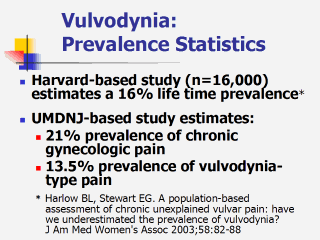| front |1 |2 |3 |4 |5 |6 |7 |8 |9 |10 |11 |12 |13 |14 |15 |16 |17 |18 |19 |20 |21 |22 |23 |24 |25 |26 |27 |28 |29 |30 |31 |32 |33 |review |
 |
The literature
estimates prevalence anywhere from 2-20% of U.S. women. A variety of studies
exist, most of which are small-scale and based out of case reports or
selected OB/GYN practices. For this reason, it is thought that previous
estimates were on the lower side. Recent work at Harvard University supports
this thought. Preliminary studies from a large scale (n=16,000) Harvard-based, NIH-sponsored epidemiologic study of women in the Boston area aged 18-64 years indicate a lifetime 16% prevalence of chronic vulvar burning, knife-like pain or pain on vulvar contact for 3 months or longer (1) Unpublished results of a UMDNJ-based, NIH-sponsored survey study of women patients at a University-based medical group indicate a 21% (n=378) lifetime prevalence of chronic gynecologic pain and a 13.5% (n=242) prevalence of vulvodynia-like symptoms. (1) Harlow BL,Stewart EG.A population-based assessment of chronic unexplained vulvar pain:have we underestimated the prevalence of vulvodynia?J Am Med Women's Assoc 2003;58:82-88 |